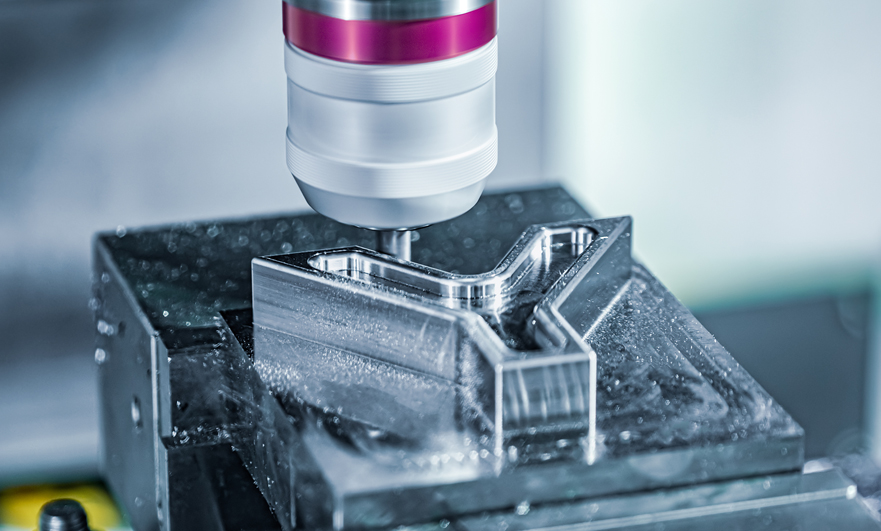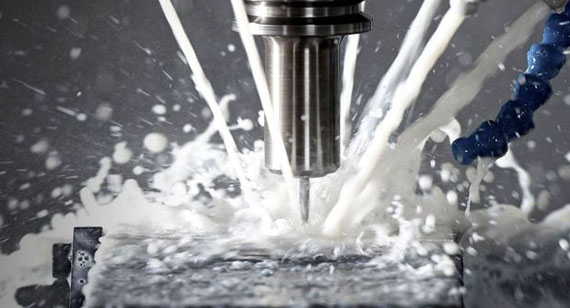15 years one-stop China custom CNC machining parts factory
 1090 |
Published by VMT at Dec 25 2021
1090 |
Published by VMT at Dec 25 2021
When it comes to aluminum CNC machining, a common challenge that manufacturers face is the appearance of discoloration, mold, or whitening on the machined parts. These issues can arise due to the lack of corrosion inhibition in the cutting fluid used during the machining process. In this article, we will delve into the reasons behind these problems and explore effective solutions to address them.
Understanding the Impact of Cutting Fluid on Aluminum Machining
Cutting fluids play a crucial role in CNC machining operations, including aluminum machining. They provide lubrication, cooling, and chip evacuation, ensuring smooth and efficient cutting. Additionally, cutting fluids help prevent tool wear and improve surface finish. However, the wrong choice or improper use of cutting fluid can lead to unwanted side effects on aluminum parts.
Common Issues Faced with Aluminum CNC Machined Parts
Discoloration of Aluminum Parts
One of the most noticeable problems encountered with aluminum CNC machined parts is discoloration. This discoloration can appear as dark patches or streaks on the surface, detracting from the aesthetics of the final product. The discoloration is primarily caused by the reaction between the aluminum and the cutting fluid, leading to the formation of oxide layers.
Mold Formation on Aluminum Parts
In certain conditions, mold or fungal growth can occur on aluminum parts. This issue arises when the cutting fluid used lacks the necessary additives to inhibit microbial growth. Mold formation not only affects the appearance of the parts but can also compromise their integrity and functionality.
Whitening of Aluminum Parts
Another common problem is the whitening or lightening of aluminum parts during machining. This phenomenon is typically caused by the removal of the protective oxide layer from the surface of the metal. The absence of corrosion inhibition in the cutting fluid exacerbates this issue.
Aluminum and aluminum alloys have good fluidity and plasticity, but they tend to turn black during use. why? The reasons for the black surface of aluminum CNC machined parts are as follows:
1. Unreasonable process design
Improper handling of aluminum CNC machined parts after cleaning or pressure testing creates conditions for the aluminum CNC machined parts to turn black and accelerate mildew.
2. Improper storage management
When aluminum CNC machining parts are stored in warehouses of different heights, their mildew conditions are also different.
3. Internal factors of aluminum alloy
Many aluminum CNC machining parts factories do not perform any cleaning treatment during die casting and CNC machining, or just wash with water, which cannot be thoroughly cleaned. There are corrosive substances such as mold release agents, cutting fluids, saponification fluids and other substances on the surface of die-cast aluminum CNC machining parts. These stains accelerate the speed of black mold spots on aluminum CNC machining parts.
4. External environmental factors of aluminum alloy
Aluminum is an active metal, which is easily oxidized to black or moldy under certain temperature and humidity conditions, which is determined by the characteristics of aluminum itself.
5. Choosing a cleaning agent is inappropriate
The selected cleaning agent is very corrosive, causing corrosion and oxidation of aluminum CNC machined parts.

Aluminum corrosion inhibition is one of the important functions of aluminum alloy cutting fluids. Different series of aluminum alloys have different anti-corrosion capabilities and require cutting fluids to provide better corrosion inhibition.
The Role of Corrosion Inhibition in Cutting Fluids
Corrosion inhibition is critical when machining aluminum. It involves the use of additives in the cutting fluid to prevent or minimize the reaction between the aluminum and the fluid. These inhibitors form a protective layer on the surface of the metal, shielding it from corrosive elements and preventing discoloration, mold formation, and whitening.

Aluminum corrosion inhibition effect of different cutting fluids
1. In immersion test or use, the appearance of aluminum CNC machined parts is obviously black, indicating that the cutting fluid aluminum has a poor corrosion inhibition function and cannot meet the requirements of the working conditions;
2. In immersion test or use, the appearance of aluminum CNC machined parts is obviously whitish, indicating that the cutting fluid is too alkaline, the pH is too high, and alkali corrosion occurs on the surface.
3. After the aluminum CNC machined parts are stored in the warehouse for a period of time after processing, all the aluminum CNC machined parts show mildew, indicating that the aluminum corrosion inhibition function of the cutting fluid does not support long-term storage, or the warehouse is humid and not ventilated.
4. Aluminum CNC machined parts are processed from the CNC machine tool, rinsed with tap water, and stored for a short time, showing mildew stains, because the corrosion inhibitor components on the surface of the aluminum CNC machined parts have been removed, which can not provide protection.
5. Aluminum CNC machined parts become black and moldy after shot blasting, and corrosion problems are still present after CNC machining. The storage environment of aluminum CNC machined parts is humid and the residence time is long. It is necessary to shorten the stay time as much as possible.
The appearance of aluminum CNC machining parts is black, and the appearance of aluminum CNC machining parts is white. Especially in the high temperature and humid environment in summer, aluminum corrosion problems emerge in an endless stream. There is no problem after CNC machining. Various problems appear after subsequent cleaning. Comprehensive analysis is required. The result is to find the cause of the problem.
Solutions to Address the Lack of Corrosion Inhibition
Selecting the Right Cutting Fluid
Choosing the appropriate cutting fluid is essential to avoid the issues mentioned above. Opt for cutting fluids specifically formulated for aluminum machining. These fluids often contain corrosion inhibitors tailored to protect the metal and minimize discoloration, mold, and whitening.
Regular Maintenance and Monitoring
Regular maintenance of the cutting fluid system is crucial to ensure its optimal performance. Monitor the fluid's pH level, concentration, and contamination levels regularly. Maintain the recommended levels by adding fresh fluid or adjusting the concentration as necessary. Additionally, ensure proper filtration to remove any contaminants that can contribute to the problems.
Implementing Corrosion Inhibitors
If you're experiencing persistent discoloration, mold formation, or whitening despite using appropriate cutting fluids, consider incorporating additional corrosion inhibitors. Consult with experts or cutting fluid suppliers to identify suitable inhibitors and their recommended application methods. Implementing these inhibitors can enhance the corrosion resistance of the cutting fluid and address the associated issues.
Whether it is aluminum alloy cutting fluid or aluminum alloy cleaning agent, it is necessary to meet the needs of aluminum corrosion inhibition, and to avoid problems as much as possible when used in combination.
How to Address Surface Discoloration, Mold, and Whitening in Aluminum CNC Machined Parts Due to Insufficient Corrosion Inhibition in Cutting Fluid?
Aluminum CNC machining is a widely used manufacturing process, but it can be plagued by surface discoloration, mold formation, and whitening of the parts. These issues are often caused by the lack of sufficient corrosion inhibition in the cutting fluid used during the machining process. Fortunately, there are several effective solutions to address these problems and ensure high-quality aluminum CNC machined parts.
1. Choose the Right Cutting Fluid
Selecting the appropriate cutting fluid specifically designed for aluminum machining is crucial. Look for cutting fluids that contain corrosion inhibitors tailored for aluminum. These inhibitors form a protective layer on the surface of the metal, preventing the reaction between aluminum and the cutting fluid, and minimizing discoloration, mold formation, and whitening.
2. Monitor and Maintain the Cutting Fluid
Regularly monitor the cutting fluid's pH level, concentration, and contamination. Maintain the fluid within the recommended parameters by adding fresh fluid or adjusting the concentration as needed. Proper filtration and removal of contaminants will help ensure the cutting fluid's optimal performance in inhibiting corrosion.
3. Implement Corrosion Inhibitors
If discoloration, mold, or whitening issues persist, consider incorporating additional corrosion inhibitors into the cutting fluid. Consult with experts or cutting fluid suppliers to identify suitable inhibitors and their recommended application methods. These inhibitors can enhance the corrosion resistance of the cutting fluid, further mitigating the surface-related problems.
4. Optimize Machining Parameters
Review and adjust the machining parameters such as cutting speed, feed rate, and depth of cut. High cutting speeds and aggressive feed rates can lead to excessive heat, which may promote oxidation and surface discoloration. By optimizing these parameters, you can reduce heat buildup during machining.
5. Ensure Proper Chip Evacuation
Efficient chip evacuation is crucial in preventing chip recutting and drag, which can contribute to surface discoloration. Proper chip evacuation minimizes heat generation and reduces the chances of oxidation on the aluminum part's surface.
6. Improve Tool Cooling
Enhance the cooling of cutting tools during machining to reduce friction and heat generation. Adequate tool cooling will help prevent excessive temperatures on the surface of the aluminum part and reduce the risk of discoloration.
7. Use High-Quality Cutting Tools
Invest in high-quality cutting tools with suitable coatings and materials that can dissipate heat effectively. Properly selected and maintained cutting tools will enhance performance and reduce the likelihood of surface-related issues.
8. Optimize Workpiece Fixturing
Ensure the proper fixturing of the aluminum part during machining to minimize vibrations and improve cooling. Proper fixturing reduces localized heating, helping to avoid surface discoloration.
9. Control Machining Environment
Maintain a controlled machining environment by managing humidity, airborne contaminants, and ambient temperature. These factors can influence oxidation rates and the occurrence of surface-related problems.
By implementing these solutions, manufacturers can effectively address the surface discoloration, mold formation, and whitening issues in aluminum CNC machined parts due to insufficient corrosion inhibition in the cutting fluid.
Conclusion
Discoloration, mold formation, and whitening of aluminum CNC machined parts can be distressing for manufacturers. However, by understanding the role of cutting fluids and corrosion inhibition, it becomes possible to address these issues effectively. Selecting the right cutting fluid, maintaining the fluid system, and implementing corrosion inhibitors are key steps to ensure the longevity and quality of aluminum parts.
Frequently Asked Questions (FAQs)
How does cutting fluid affect aluminum machining?
Cutting fluids provide lubrication, cooling, and chip evacuation during aluminum machining. However, improper cutting fluid selection or use can lead to issues like discoloration, mold formation, and whitening on aluminum parts.
What causes discoloration in aluminum CNC machined parts?
Discoloration in aluminum parts is primarily caused by the reaction between the aluminum and the cutting fluid. This reaction leads to the formation of oxide layers, resulting in dark patches or streaks on the surface.
How can mold formation on aluminum parts be prevented?
Mold formation on aluminum parts can be prevented by using cutting fluids that contain additives with corrosion inhibition properties. These inhibitors inhibit microbial growth and prevent mold formation.
Why do aluminum parts turn white during machining?
Aluminum parts turn white during machining when the protective oxide layer on the surface of the metal is removed. The absence of corrosion inhibition in the cutting fluid exacerbates this issue.
Are there any specific cutting fluids designed for aluminum?
Yes, there are cutting fluids specifically formulated for aluminum machining. These fluids contain corrosion inhibitors tailored to protect the metal and minimize discoloration, mold, and whitening.
